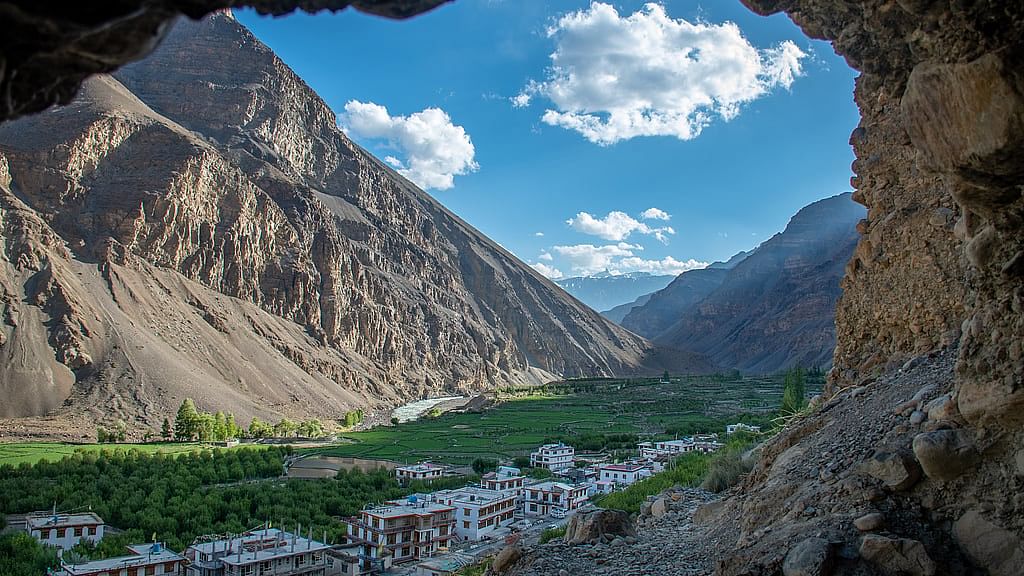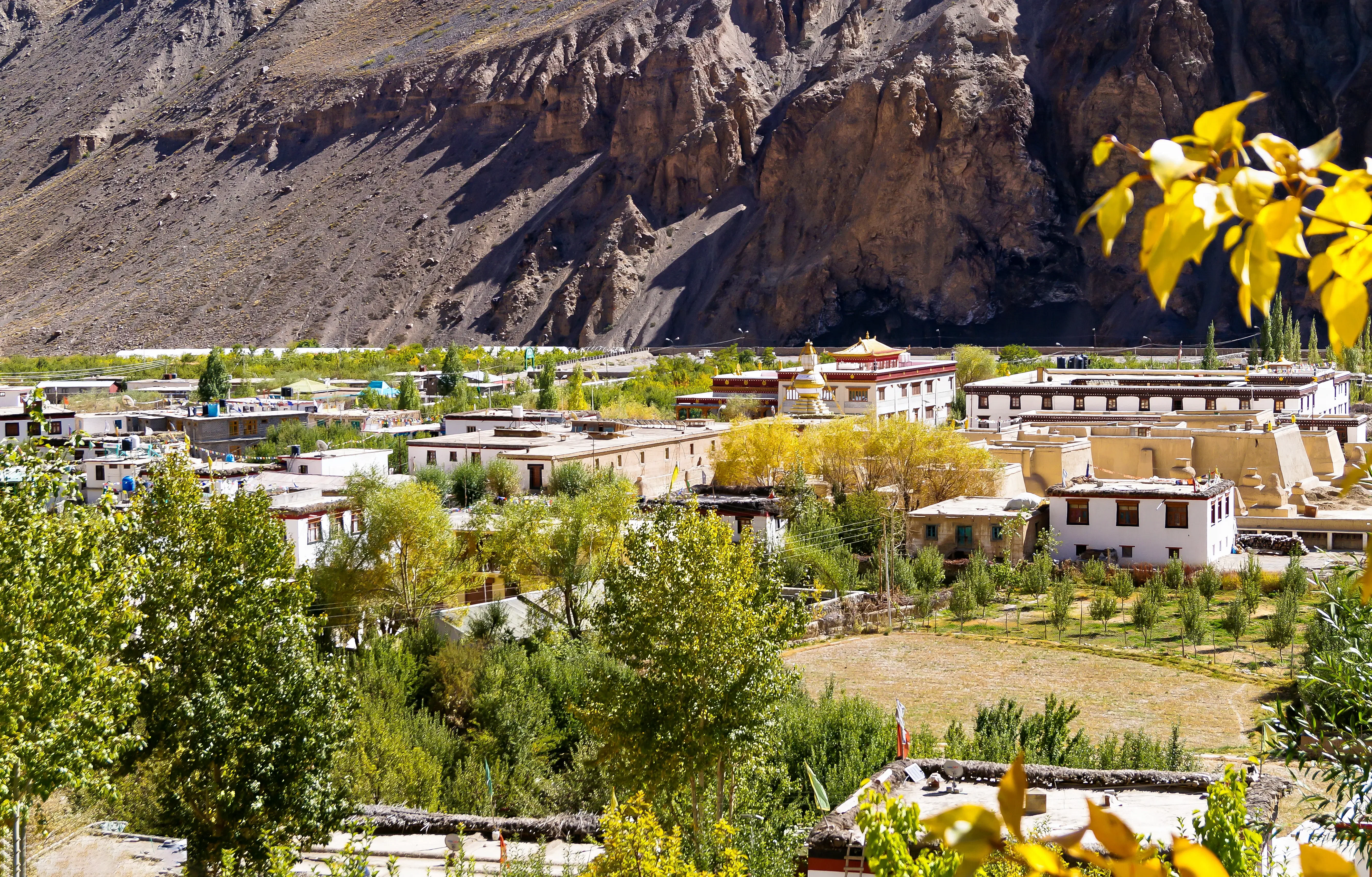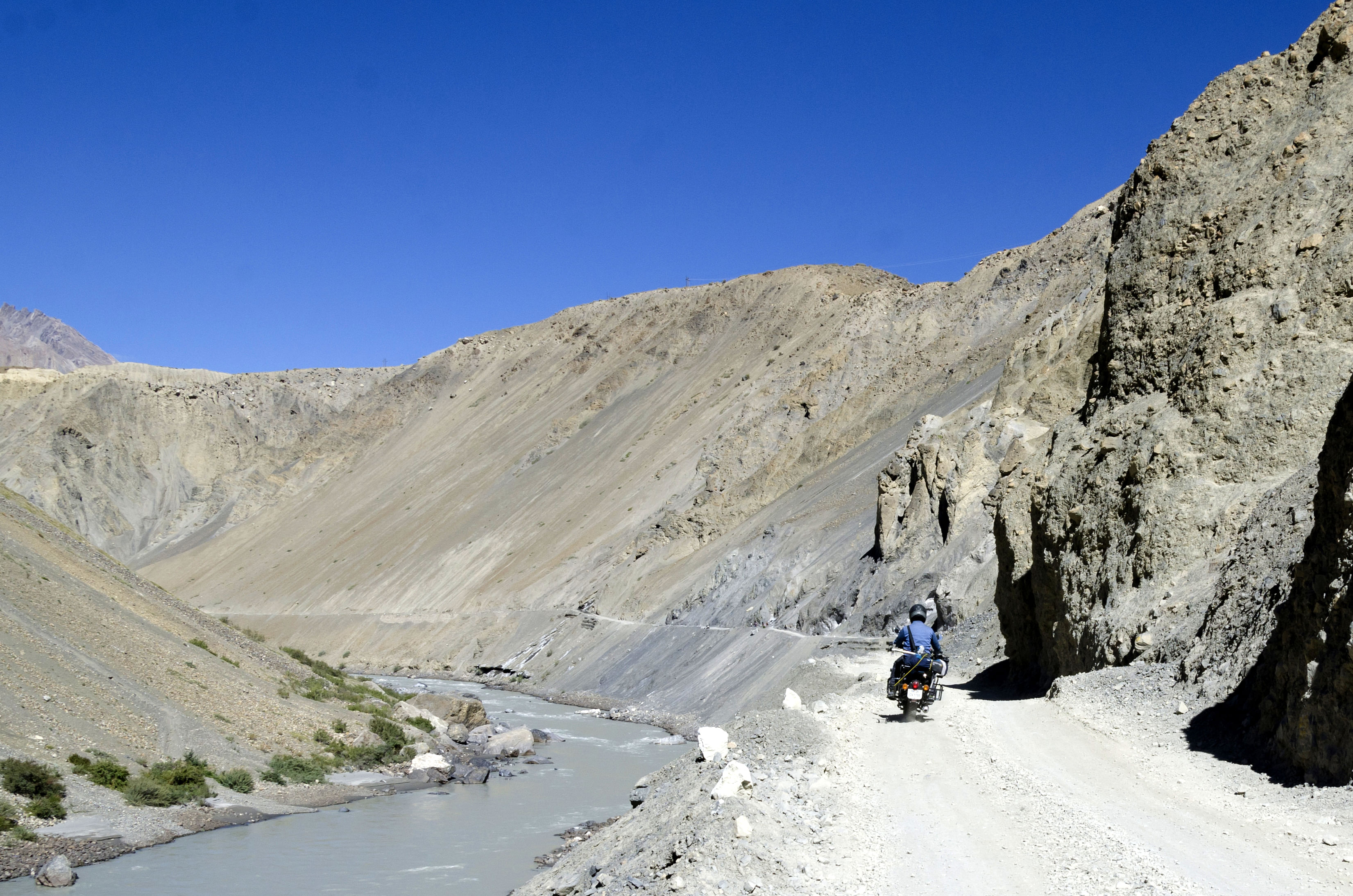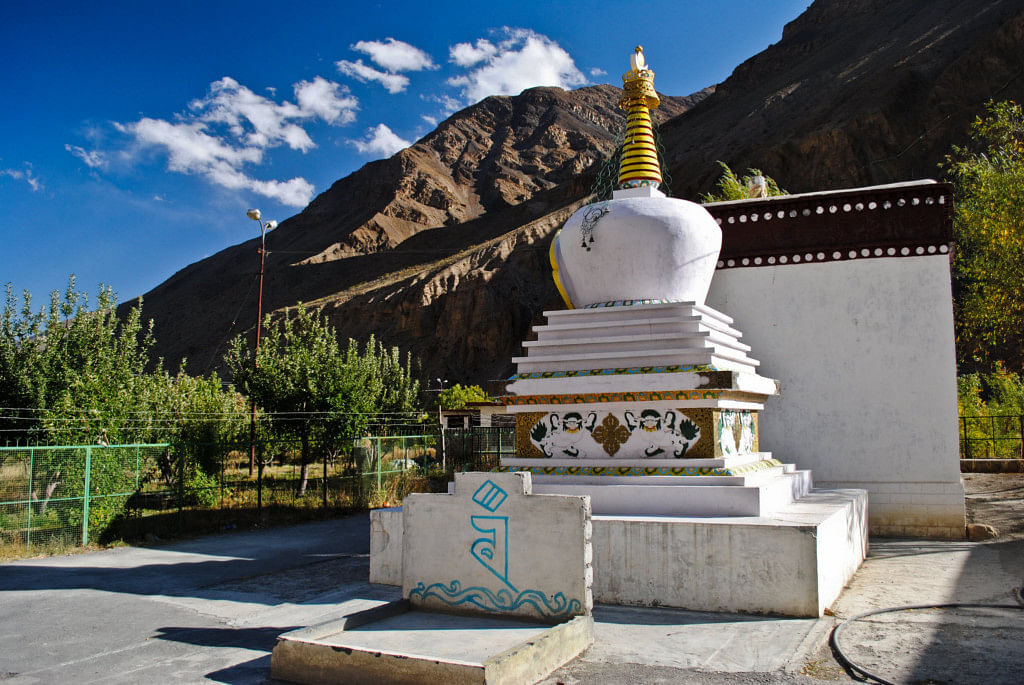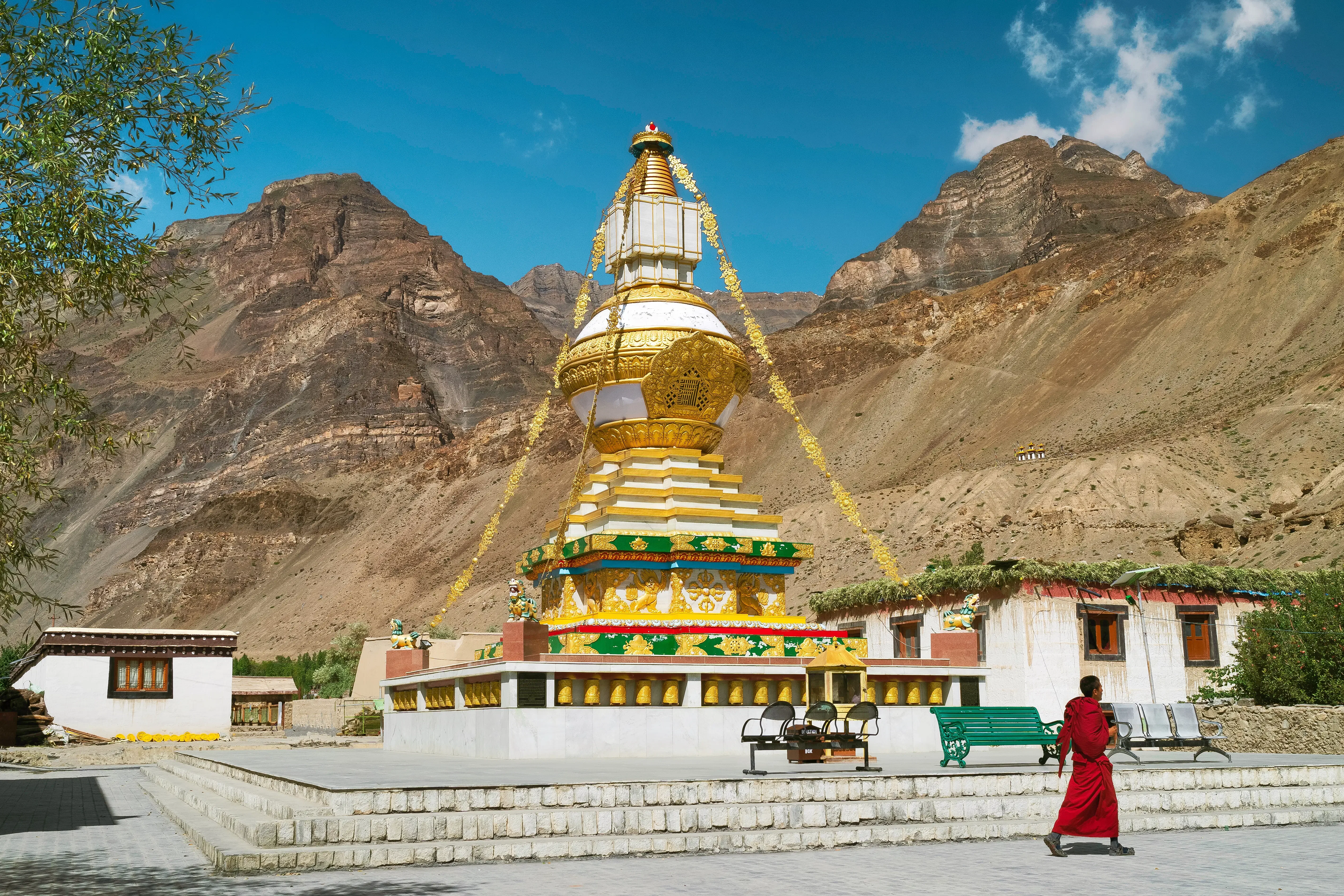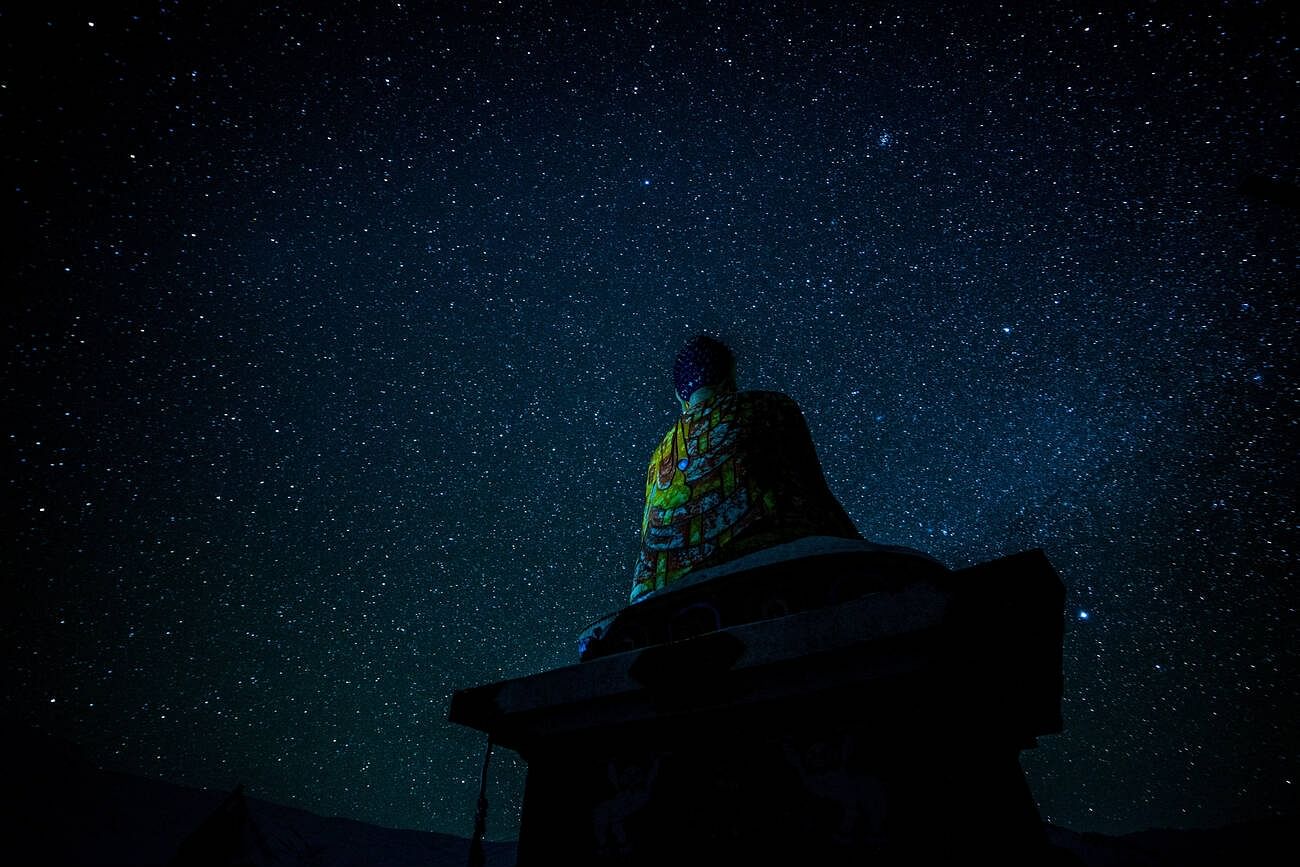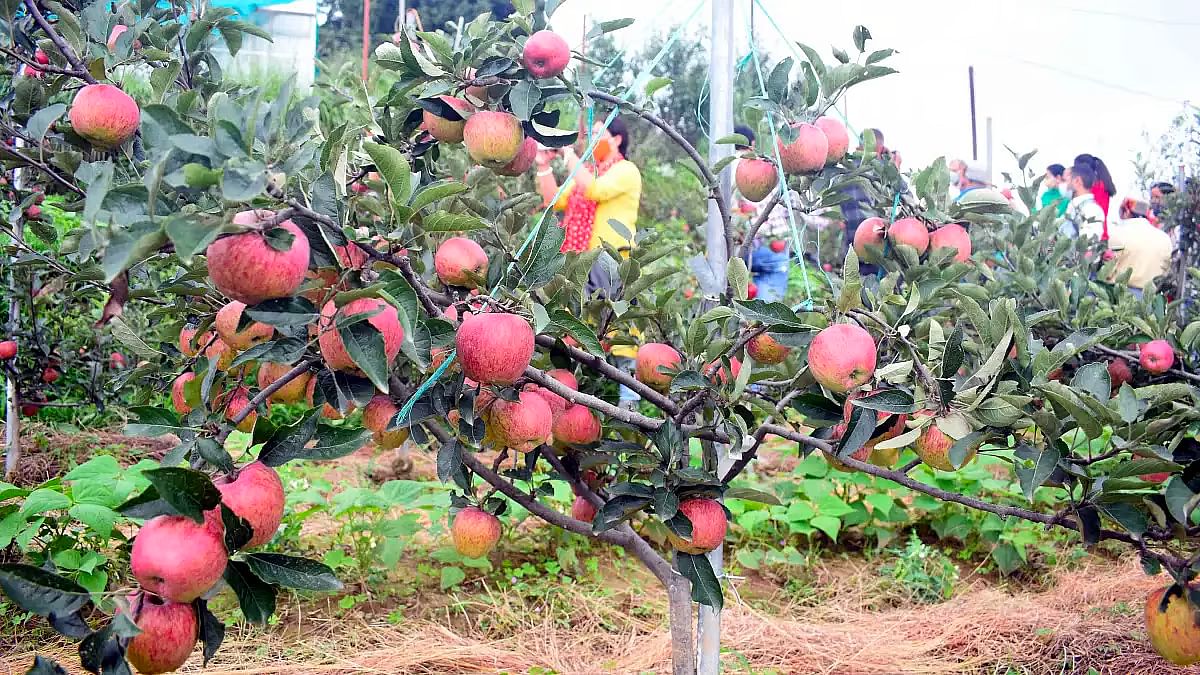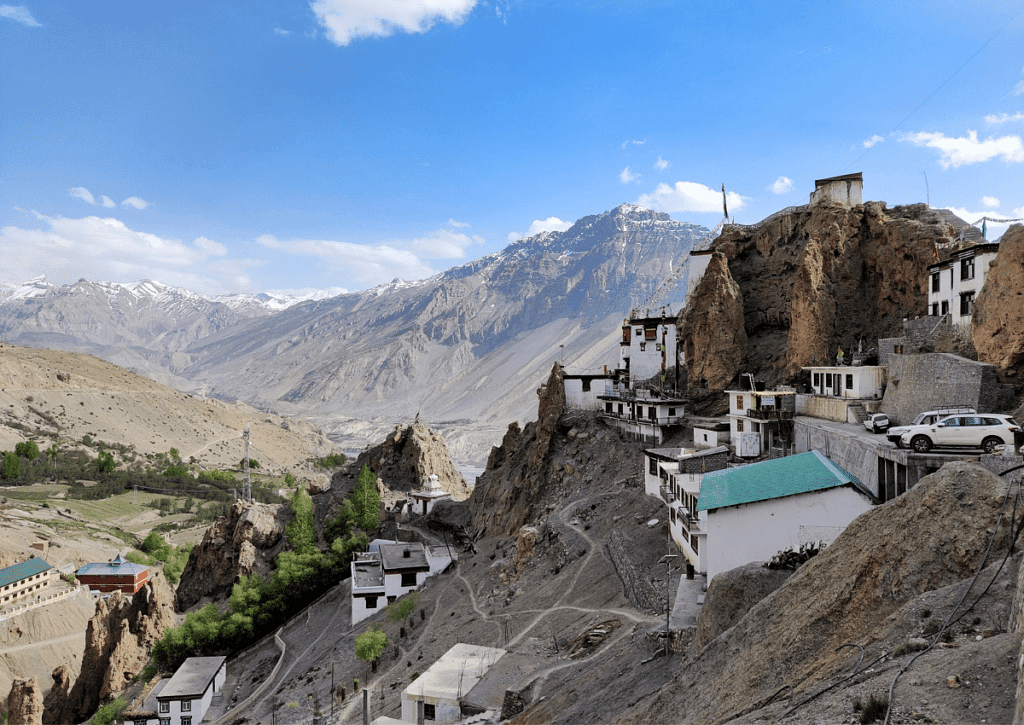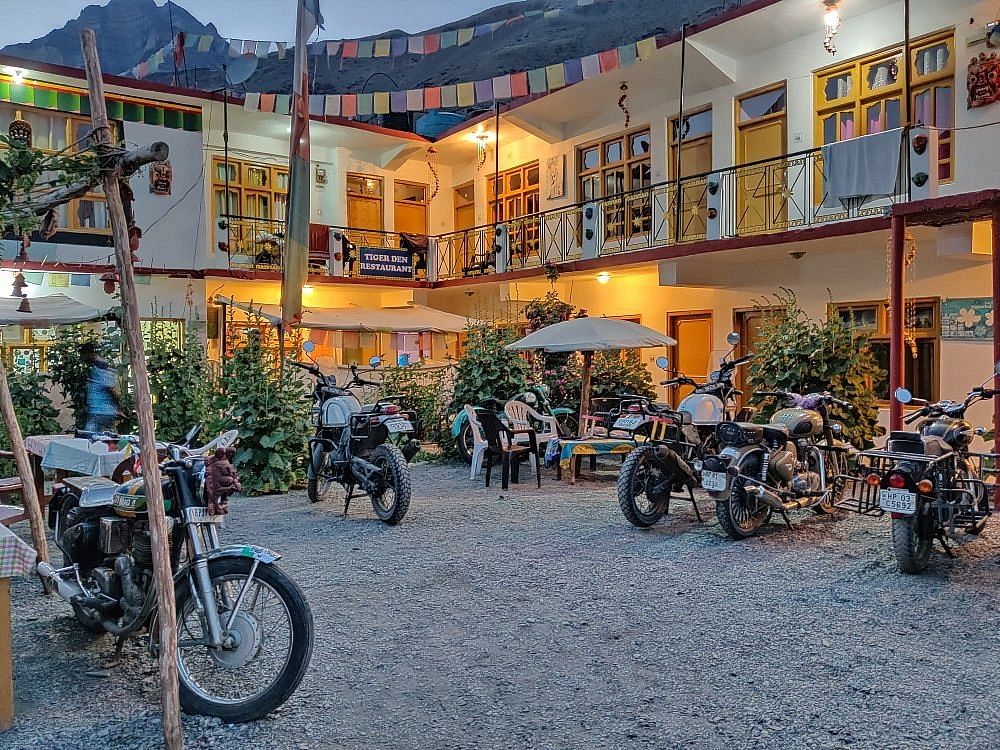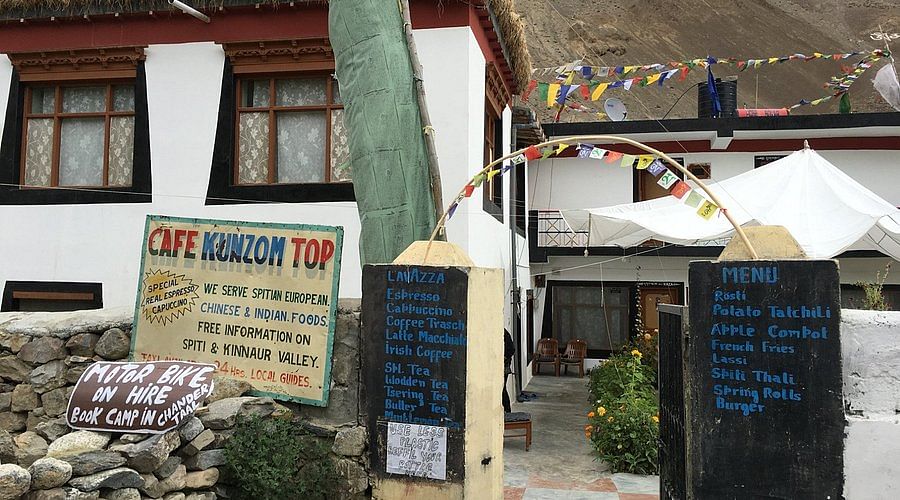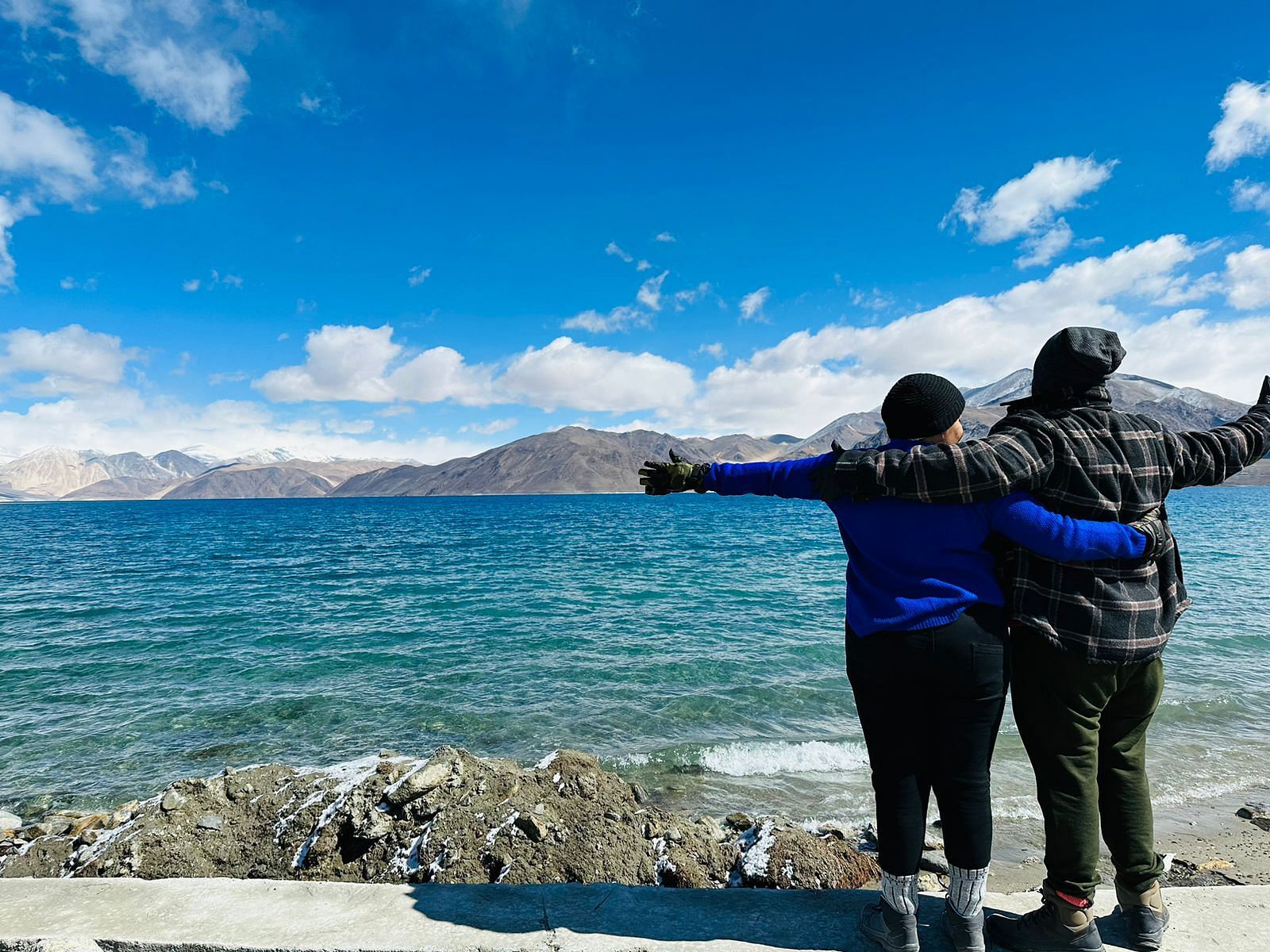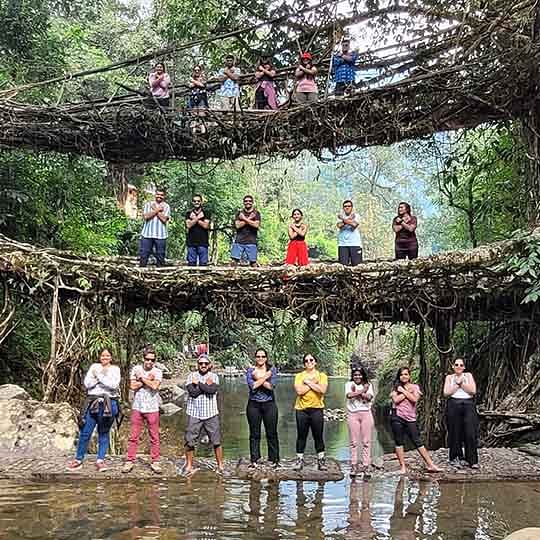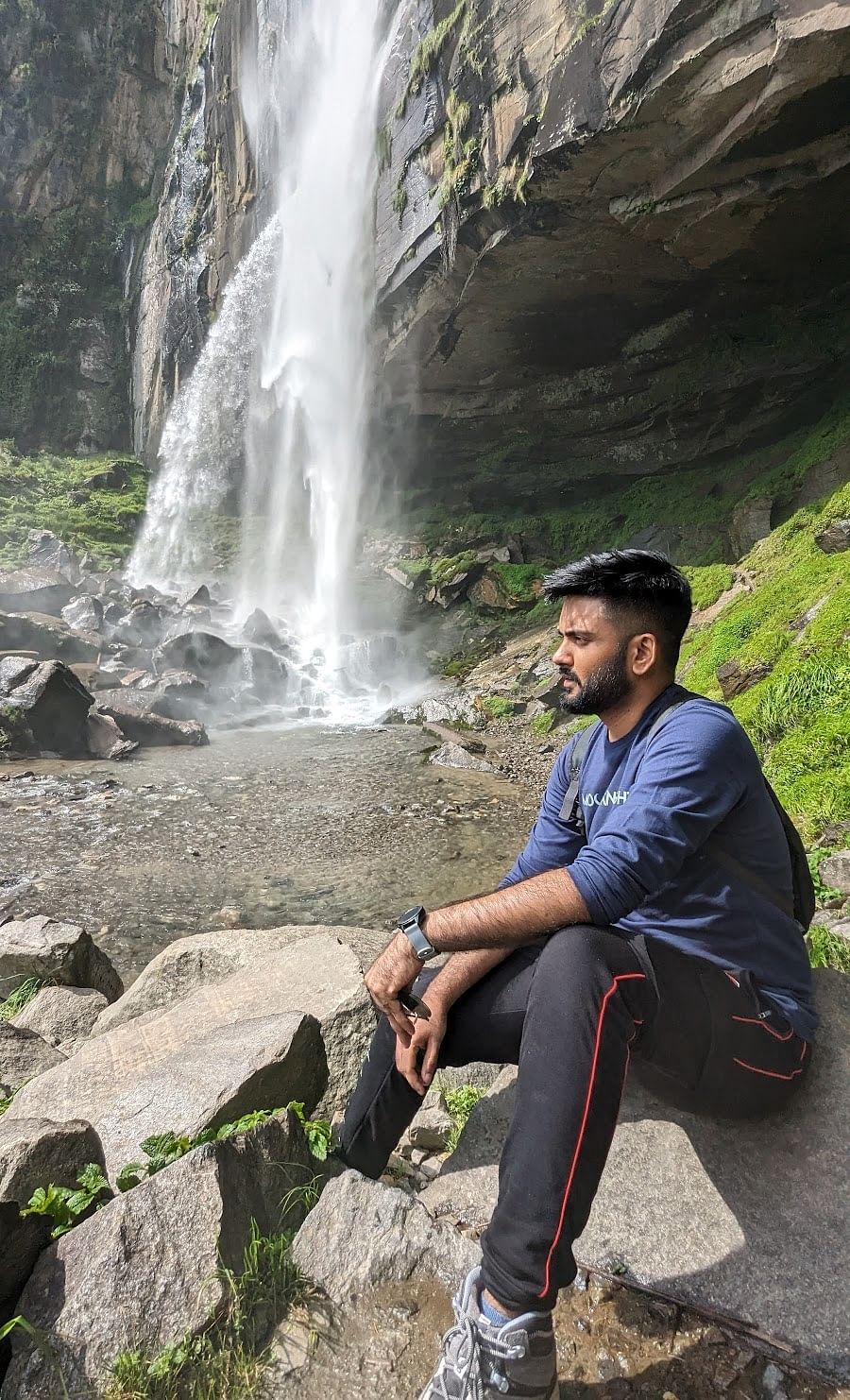Tabo Village, a quiet little masterpiece hiding in the middle of the dramatic, rocky region of Spiti Valley! The place does not have any big city drama, no traffic, and definitely no crowds. Then, what does it have? It is known for the 1000-year old iconic Tabo Monastery, also known as the Ajanta of the Himalayas which is for monks, have mud-brick homes and skies so full of stars.
Coming here would feel like pausing your life and just enjoying your main character energy in this stunning location. Located 40 Kilometers away from the border between India and Tibet, you are bound to come across it when traveling by road from Kaza to Reckong Peo.
But, Tabo Monastery is known as one of the best attractions in Tabo village, as it is considered to be the holiest by the Dalai Lama himself. Also, housing several temples and some ancient Tabo caves which were once inhabited by Buddhist monks who wanted to take shelter from the harsh winters. So, if you are planning your Spiti Valley tour, make sure to have your itinerary planned with these remote villages as well. They are remote, yet have a lot of places to explore and know about.
- Explore the ancient beauty of Tabo Monastery, also known as “Ajanta of the Himalayas”.
- You also get to witness the serene apple orchards in Tabo, experiencing the beauty of the place.
- Enjoy the stargazing experience during night if you are staying in the Tabo village.
- Visit the Tabo caves, from where you get to have a whole view of the Valley.
- There is also a remote site - Kalachakra Initiation site that is known to be blessed by the Dalai Lama.
How to reach Tabo Village
By Air: The nearest airports to Langza Village are Kullu Manali Airport or Bhuntar Airport (248 km) and Shimla Airport (267 km). However, access to other major airports is restricted from these locations. The closest major airport is Chandigarh.
By Train: The biggest railway station closest to Langza village is Chandigarh. However, you may take a toy train ride from Kalka to Shimla, which is around 463 kilometers from Tabo Village, and then plan a car journey to the village.
By Road: Tabo Village in Spiti Valley may be reached from two locations: Shimla and Manali. The direct road route from Kunzum Pass to Manali is approximately 231.1 km long, whereas the Shimla path from Kinnaur Valley is 355 km.
Also, How to reach Tabo from Kaza? (The Headquarters of Spiti Valley)
You can travel from Kaza to Tabo by:
1. Taxi or Private Car:
This is the easiest and most comfortable way. The road is mostly smooth and the views are amazing – think rocky mountains, river valleys, and blue skies.
2. Local Bus:
There are HRTC (Himachal Road Transport) buses that go from Kaza to Tabo, but they may run only once or twice a day, so check the timings in advance.
3. Shared Jeep or Cab:
These are common in Spiti. Just ask around in Kaza – you can usually find a shared ride heading toward Tabo.
The best time to visit Tabo Village
Visiting Tabo village during the winter and monsoon months is not the finest time of year. Unless you have previously visited the area, it is not suggested that you visit during these months, as the winters are extremely cold with unsettling cold waves. The terrain leading to the village is rough, especially during the monsoon season when landslides occur.
Summers are the best time in Spiti and to organize a trip to the village. Both roads from Manali and Shimla are fairly accessible during these months. The weather is good, although woolen coats and jackets will be required when the sun sets. Sunscreen, lip balms, and cold medications are essential to have while traveling here.
Things to do in Tabo Village
Tabo Monastery is one of the best places to visit in Tabo Village. This 1000-year-old monastery holds enormous significance in Buddhism. Tabo Monastery, known as the Ajanta of the Himalayas, contains various paintings, art forms, and murals depicting Buddhist religion and culture. Because of its archaeological and historical significance, the Archaeological Survey of India maintains the monastery. The paintings at the Tabo monastery are incredibly well-kept and in excellent shape, which is why people come here to see the magnificent artwork.
Kalchakara, a cultural event, was held in the presence of the Dalai Lama in 2000 and was attended by a large number of Buddhist monks and followers from all over the world. Visitors may feel the Positive vibrations at this location, where monks chant and meditate.
Suggested Read : Tayul Monastery
2. Taste the Authentic Tabo Cuisine
When visiting Spiti Valley, the cuisine is not to be missed. Tasting the food of Tobo village is an adventure in itself. Some of the most delicious dishes to try include Kiu, Chulpi, Chushi, Thukpa, and Chutrep. An aesthetically appealing aspect of dining in Spiti village is the seating arrangement, which is a tradition among the locals and tourists.
Discovering and visiting the Tabo caves in Spiti Valley is the best thing to do in Tabo village. These caves are located in and near Tabo village. There is no specific information on how old these caves are or whether they are natural or man-made. Locals claim that humans lived in these caverns many years ago to endure the severe climate.
Even today, monks utilize these caverns for meditation purposes, and they are designated with flags. These cases are old architecture marvels as they appear to be little holes, yet once within the caves, there is adequate space and enough openings for sunshine to come through. It is one of the best places to visit in Tabo Village, as you get to have a whole view from here.
As darkness falls, the sky gradually grows milkier. The Milky Way galaxy can be seen with the naked eye, and this location is a dream come true for astronomers and photographers and is considered the best thing to do in Tabo Village. This pollution-free sky is a sight to behold and a welcome respite for the overworked mind.
Apple orchids are plentiful at Tabo Village in Spiti Valley. If you visit Village between August and October, you will have the opportunity to pick some of the freshest and juiciest apples in India. It is the best activity to do in Tabo Village.
Suggested Read: Spiti Weather Guide, Memories In Mountains
Tabo village distance from the major cities nearby
Chandigarh
Distance: 502 Km
Travel Time: 11 hours and 58 minutes
Kullu
Distance: 270.5 Km
Travel Time: 7 hours and 5 minutes
Manali
Distance: 231 Km
Travel Time: 6 hours and 6 minutes
Shimla
Distance: 466.6 Km
Travel Time: 12 hours and 30 minutes
Delhi
Distance: 740.5 Km
Travel Time: 16 hours and 1 minute
Dharamshala
Distance: 448.7 Km
Travel Time: 12 hours and 13 minutes
Jammu
Distance: 712.2 Km
Travel Time: 16 hours and 40 minutes
Want to stay for a day at Tabo Village? Many people think of this that are there places to stay in Tabo Village? So, here are some decent options for you to book a good place to stay.
It is located very close to the Tabo Monastery, and is one of the popular hotels in Tabo village Spiti Valley. You get to have spacious rooms, furnished with a king-sized bed and other necessary furniture. Every room comes with an attached bathroom as well, telephone and other features such as free wi-fi, room service and free parking.
It is located a very few steps away from the Tabo Monastery, and is known for its brilliant service, cleanliness and value. You can access the free parking and other facilities such as room service, reception and delectable meals at the restaurant.
The best part? It also allows you to stay with your pets and is a wholly pet-friendly hotel for people who want to stay here.
It is one of the best places to stay in Tabo Village, coming with spacious rooms and modern amenities. You also get to have a wardrobe equipped in every room. You can have a good stay at this place whenever in Tabo!
Places to Eat in Tabo Village Spiti
No one wants to miss out on the authentic food in Spiti! But, you cannot expect anything luxurious or five-star dining because Spiti Valley has some excellent options in Tibetan cuisine with basic restaurants. So, here are some options you can opt for while exploring Tabo Village.
Cafe Kunzum Top - one of the best and popular places to eat in Tabo Village. It specializes in cafe food and Tibetan cuisine with breakfast options, lunch and dinner as well. Do not miss out on the amazing coffee and the dishes like spring rolls, burgers, potato, french fried and so on! If you want to try something special and unique - go for the famous “Spiti Thali” which is a must try for everyone.
Tiger Den Café in Tabo, Spiti Valley, is a cozy and welcoming spot for travelers seeking a warm meal and a comfortable place to relax. Located near the entrance of the historic Tabo Monastery, this café offers a variety of dishes, including Indian, Tibetan, and Continental options. Popular items on the menu include hummus, lemon chicken, pizzas, and pitas.
Tashi Khangsar Café is a cozy and peaceful place to relax and enjoy a meal in Tabo Spiti Valley. It's part of the Spiti Mud Huts Tabo hotel, which is near the Tabo Monastery and surrounded by apple orchards and fields of sweet peas. The café offers a variety of dishes, including Indian, Tibetan, and Continental options, and is known for its friendly atmosphere and beautiful views of the Spiti River and the barren Himalayan cliffs.
Suggested read: Spiti river
Tips for Visiting Tabo Spiti Valley
- Avoid visiting this place during the winter and monsoon seasons. It shuts down entirely due to heavy snowfall. Although this location receives plentiful rain during the monsoon season, the road leading to it is unsafe owing to landslides.
- Even in summer, carry woolen clothes since nights can be chilly and windy.
- Only the BSNL connection works at this place. There is no proper network connectivity. So come prepared with a complete cut-off from the outside world.
- When traveling to the village, keep your car’s fuel tanks topped, as there are no petrol pumps or even mechanics available.




